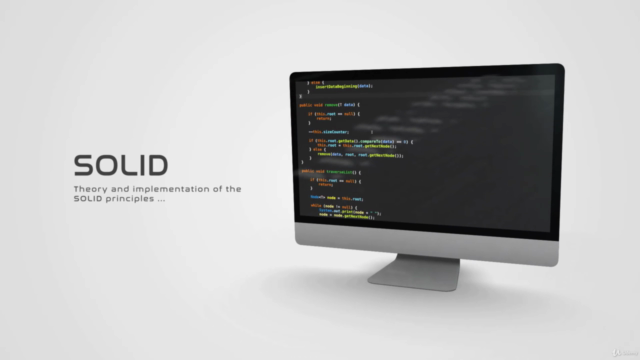Software Architectures (SOLID) & Design Patterns in Java

Why take this course?
🌟 Course Title: Software Architecture (SOLID) & Design Patterns in Java 🚀
Course Headline: A Guide to Create Smart, Reusable Softwares with SOLID Principles and Design Patterns! 🏗️✨
Introduction to the Course
Dive into the world of software architecture and design patterns with our comprehensive course designed to enhance your skills in writing clean, maintainable, and scalable code. Whether you're a seasoned developer or just starting out, understanding SOLID principles and applying design patterns is crucial for crafting robust software solutions.
Section 1 - Understanding SOLID Principles
The SOLID principles are the foundation of object-oriented programming and they help us to write more maintainable and scalable code. They stand for:
- Single Responsibility Principle (SRP): A class should have only one reason to change.
- Open Closed Principle (OCP): Software entities should be open for extension but closed for modification.
- Liskov Substitution Principle (LSP): Objects of a superclass should be replaceable with objects of a subclass without altering the correctness of the program.
- Interface Segregation Principle (ISP): Clients should not be forced to depend on methods they do not use.
- Dependency Inversion Principle (DIP): High-level modules should not depend on low-level modules. Both should depend on abstractions.
🔍 What is Dependency Injection? This is a technique used to implement the Dependency Inversion Principle, allowing for more modular and testable code.
Section 2 - Creational Design Patterns
Creational patterns help in creating objects without specifying the exact class of object that will be created. They include:
- Singleton Pattern: Ensures a class has only one instance and provides a global point of access to it.
- Factory Pattern: Provides an interface for creating objects in a superclass, but let subclasses decide which class to instantiate.
- Abstract Factory Pattern: Enables the creation of families of related or dependent objects without specifying their concrete classes.
- Builder Pattern: Helps construct complex objects step by step.
- Prototype Pattern: The prototype mechanism lets new objects be created from copying an existing object, known as the prototype.
Section 3 - Behavioral Design Patterns
Behavioral patterns are concerned with algorithms and the assignment of responsibilities between object abstractions. These patterns include:
- Strategy Pattern: Defines a family of algorithms, encapsulates each one, and makes them interchangeable.
- Observer Pattern: Used to define a dependency between objects so that when one object changes state, all its dependents are notified and react to the event.
- Command Pattern: Encapsulates a request as an object, thereby letting you parameterize clients with queues of requests and support undoable operations.
- Iterator Pattern: Provides a way to access the elements of an aggregate object sequentially without exposing its underlying representation.
- Template Method Pattern and Null Object Pattern: The template method defines the skeleton of an algorithm, deferring some steps to subclasses. The null object acts as a default, typically singleton instance that fulfills the role of any object within a given domain.
- Visitor Pattern: Lets you separate algorithms from the objects on which they operate.
Section 4 - Structural Design Patterns
Structural patterns are concerned with how classes and objects are composed to form larger structures. These include:
- Decorator Pattern: Dynamically add or remove behaviors at runtime without affecting other parts of the system.
- Flyweight Pattern: Reduces memory usage by sharing as much state as possible with mutable shared state.
- Facade Pattern: Provides a simplified interface to a complex subsystem.
- Adapter Pattern: Allows incompatible interfaces to work together.
Model-View-Controller (MVC) Pattern
Understanding the MVC pattern is essential for designing user interfaces that are responsive and maintainable. We will explore how this pattern separates an application into three interconnected components:
- The model, which represents the data and business logic.
- The view, which can draw and display the model's data to the user.
- The controller, which handles the user input and converts it to actions on the model or view.
Why Learn These Concepts?
In today's fast-paced software development environment, understanding SOLID principles and design patterns is crucial for building applications that are easy to maintain, extend, and test. These practices enable developers to handle increasingly complex systems with confidence and skill.
Your Learning Journey Awaits! 🧐🚀
Join us in this enlightening journey through the world of software architecture and design patterns. With hands-on Java implementations and a focus on real-world applications, you'll be well-equipped to tackle complex problems and create high-quality software solutions.
Let's embark on this adventure together! Enroll now and start mastering the art of software design! 🛠️💻🎓
Course Gallery




Loading charts...